James Madia

Power outages across much of Texas and rotating blackouts in California over the past year are reminders of the critical importance of reliable electric power. Past large-scale outages in the U.S. have resulted in loss of life, serious injury, social unrest, and economic impacts in the billions of dollars. The 2003 Northeast and 1977 New York blackouts are examples of consequences on this scale. What about intentional attacks on critical infrastructure? Could a malicious attack of the power grid lead to these types of catastrophic consequences? Are threat actors even motivated to conduct physical attacks against electric infrastructure (EI)? If so, can the experts quantify that threat and possibly predict which actors are most likely to conduct such attacks? I spent five years exploring these questions, which ultimately led to the completion of my doctoral dissertation at the Sol Price School of Public Policy at the University of Southern California. The following summarizes a portion of what I uncovered during my journey.
Over the past decade, the anecdotal evidence has suggested that the threat of a grid attack is serious, if not imminent. Experts from a wide range of disciplines have asserted that a host of terrorist groups and other sub-state actors are plotting to bring down the U.S. power grid with a coordinated attack. These claims have become a common theme in government reports, industry journals, and academic articles. The Center for the Study of the Presidency and Congress, in its 2014 report Securing the U.S. Electrical Grid, called the nation’s power grid “an obvious target to a range of actors who would seek to strike at the U.S. homeland” (p. 4). The National Energy Technology Laboratory (2007) wrote, “The threat of both physical and cyber-attack is growing and a widespread attack against the infrastructure cannot be ruled out” (pp. A3-16). The National Research Council (2012) said that “terrorists could destroy key elements of the electricity generation and delivery system, causing blackouts that are unprecedented in this country in duration and extent” (p. 7). These and other alarming reports have influenced much of the electric utility industry’s current regulation.
I was not satisfied with these anecdotal reports to support the underlying argument, as these reports did little to establish the scope of the threat or quantify the likelihood of future attacks. A more empirically based analysis was needed to better understand the threat, using a statistically valid sample of actual EI attacks.
Is the threat real and serious?
I researched terrorist attack data from 1970-2018 available through the University of Maryland National Consortium for the Study of Terrorism and Responses to Terrorism (START) Global Terrorism Database (GTD). This included 192,211 documented terrorist attacks against a wide range of targets worldwide. During that period, terrorist groups were responsible for 4,310 attacks against electric utilities. Considering the geopolitical shifts immediately preceding the 9/11 terrorist attacks and the trends since that time, I focused my specific analysis on the 1,198 EI attacks since 2000. This is not an insignificant number of attacks, which seems to support the assertion that the threat is serious, but this number is only about 1 percent of the 121,628 total terrorist attacks conducted during the same period. However, this only accounts for attacks involving groups defined by START as “terrorist groups” and does not include many attacks by nation states, lone wolves, other sub-state actors, or activist groups.
Some pundits have argued that these attacks only occur in conflict zones or countries described as failed states, with few or no attacks occurring in the United States. Conflict zones such as Iraq, Syria, Libya, and Yemen come to mind as locations where there have been many EI attacks. My primary research data sample identified attacks conducted by 71 different sub-state groups in 38 different countries located in 10 distinct regions of the world, including North America, Western Europe, the Middle East and Levant, North Africa, Central Asia, Southeast Asia, South America, Eastern Europe, Sub-Saharan Africa, and South Asia.
Aside from the statistical analysis, I found value in the examination of U.S. attacks from open-source reporting. The following table is a sample of attacks that have occurred in the United States since the 1980s. These and other attacks in the U.S. and other developed nations further support the theory that the threat is real.
Date Location Attack Summary
August 1987 Independence, Calif. Million-volt transmission line carrying power across Pacific Intertie to Southern California was sabotaged when two transmission towers were toppled (Associated Press, 1987).
April 1990 Santa Cruz, Calif. Pacific Gas & Electric transmission poles toppled over a two-day period, leaving 95,000 customers in Santa Cruz County and 92,000 customers near Watsonville without power. Group calling itself Earth Night Action Group claimed responsibility, citing Earth Day as its motive (Parrish, 1990).
October 2003 Oregon / California Bolts removed from 500 kV transmission towers on the Pacific DC Intertie. FBI arrested a man who was sentenced to 27 months in federal prison (Lerten, 2003).
October 2004 Oak Creek, Wis. High-voltage transmission towers knocked over, causing 17,000 customers to lose power and interrupted train service from Milwaukee to Chicago for 24 hours (Associated Press, 2004).
August – October 2013 Little Rock, Ark. Transmission towers toppled and high-voltage line struck a moving train. Fire started at a substation causing outage to 10,000 customers. FBI arrested a man who was sentenced to 15 years in prison (FBI Bulletin, November 2013).
June 2014 Nogales, Ariz. A homemade bomb found near a 50,000-gallon diesel storage tank at the Valencia power generation facility (Patel, 2014).
July 2013 – January 2014 New Jersey Eight separate acts of sabotage committed at facilities in New Jersey over a seven-month period (N.J. ROIC, 2014).
November 2014 Franklin Township, Pa. The shooting of electrical transformer results in $357,000 in damage (Associated Press, 2014).
March 2016 Tyngsborough, Mass. Incendiary devices placed on high-voltage transmission lines, which detonated and caused a brush fire. Man is arrested and facing 20 years in prison. (U.S. Department of Justice, 2016).
September 2016 Kanab, Utah Sniper attack on Garkane Energy substation affects 13,000 customers and costs $1 million (Walton, 2016).
April 2018 Lake Worth, Fla. Possible shooting of a large transformer at a major substation causing blackout of 27,000 customers (Capozzi, 2018).
January 2019 Asheboro, N.C. Man charged with shooting electrical transformer and causing power outage (Strange, 2019).
The most serious U.S. electric utility incident occurred on April 16, 2013, when the Pacific Gas and Electric (PG&E) Metcalf Transmission Substation near San Jose, Calif., was attacked by a group of unknown armed assailants. Using what authorities determined to be assault rifles, the attackers severely damaged ten 500-kilovolt (kV) transformers, three 230kV transformers, and six 115kV circuit breakers. The attack cost PG&E $26 million in repair costs and environmental cleanup efforts and nearly blacked out parts of the Silicon Valley. Experts have debated the motivation for the attack since the attackers have never been identified. There has been no determination as to whether the attack was a terrorist operation, insider action, or something else (Department of Homeland Security & Department of Energy, 2014; Cicale, 2014; Parfomak, 2014; Smith, 2014; Pagliery, 2015). The Metcalf attack exposed the vulnerability of our nation’s electric infrastructure and reignited longstanding fears that terrorists and other actors sought to attack the power grid.
Is the threat increasing?
During the analysis of the energy infrastructure and electric utility attacks occurring between 2000-2018, I identified a trend of increasing attack frequency. The graph below illustrates the rising number of global terrorist attacks against electric infrastructure specifically and energy infrastructure attacks more generally (gas, oil and electric combined) since 2000. At the beginning of the millennium, the frequency of attacks remained mostly unchanged year-over-year until 2008. In 2008, EI attacks increased by 244 percent from the previous year. After 2008, the overall statistical trend reflected a steep rise in attacks, peaking in 2016 with 209 EI attacks or 2,512 percent more attacks than in 2000. Even the highest year in the first decade of the millennium (2009 with 72 attacks) was 190 percent lower than the 2016 total. The number of overall energy and EI-specific attacks declined in 2017 and 2018, yet even after the peak, the number of attacks remained well above the millennium’s early years. This 19-year attack trend can reasonably support a prediction of increasing threat.
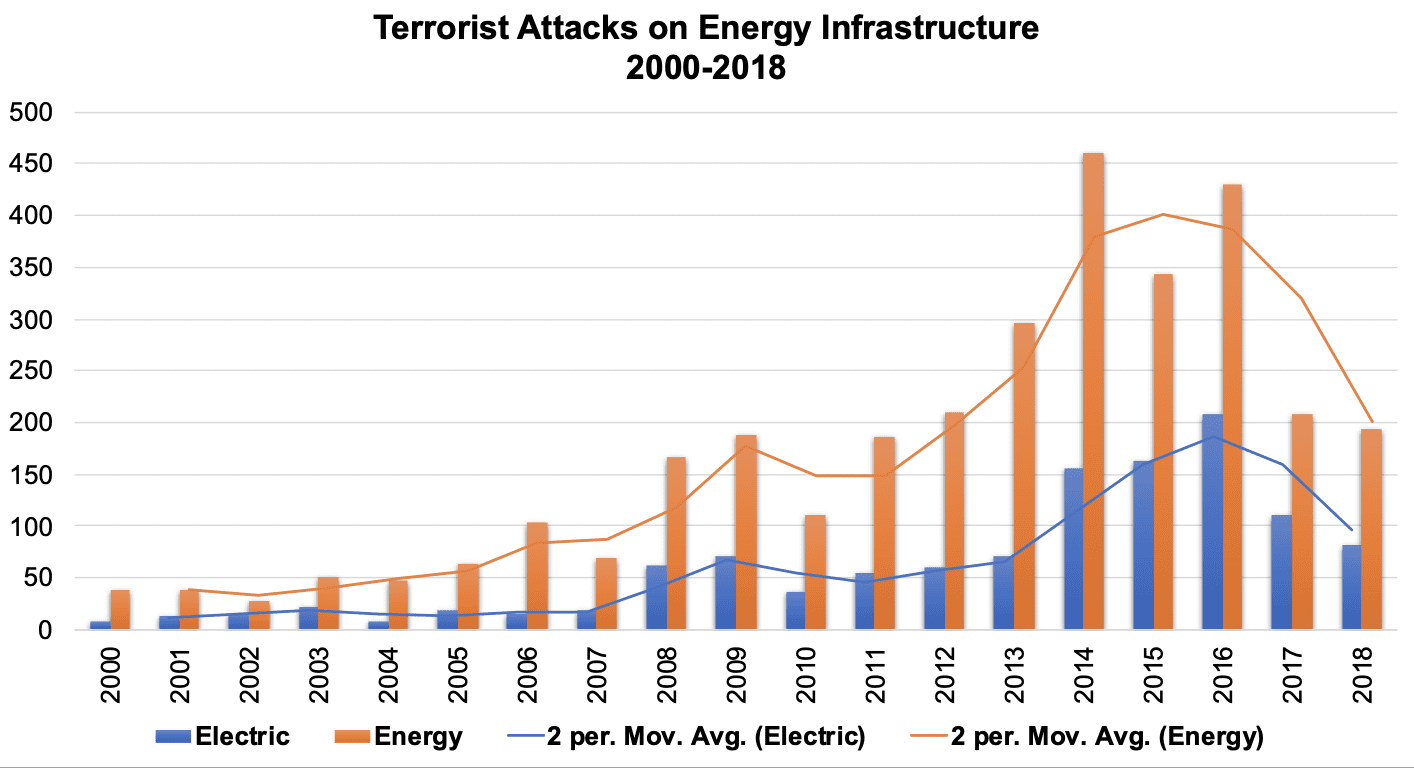
Which factors influence decisions to attack electric infrastructure?
Numerous factors influence sub-state groups when they consider targets of interest. This is true of many targets, which includes decisions to attack EI. My research involved the use of an extensive list of decision factors synthesized from the terrorism literature. The literature included a range of quantitative and qualitative sources spanning a 40-year period. The most salient decision factors were identified using a form of blended meta-analysis. The analysis utilized a scoring method, conditioned upon a subjective numeric score (1-5) for each of three criteria. The overall scores were the sums of those individual criterion scores. The list below depicts the decision factors with the highest scores.
Factors that scored high in the analysis include a group’s stated interest in the target, the security level at the target, and the proximity of the target to the group’s area of operation. Unfortunately, the START-GTD data did not capture this information, and the research necessary to code for these would have required more resources than were available for this work. Given the size of the dataset, it was impractical to code for all these factors. The remaining five factors (e.g., ideology, age, size, operational resources, and previous attacks of similar targets) were identified as the independent variables for the research and tested against the attack dataset.
Which groups attack electric infrastructure?
The research yielded some insights regarding which groups tend to select EI as a target for attack. The analysis focused on the ideology, age, size, and operational resources of terrorist groups and how those factors influenced target selection, particularly attacks of EI. Similar analysis included the number of repeat attacks on EI targets by individual groups.
When quantifying EI attacks by ideology, most attacks were conducted by ethno-nationalist/separatist groups (35 percent) or blended groups that were a combination of ethno-nationalist/separatist and religious (45 percent) as depicted in the two graphs below.

This propensity of ethno-nationalist and similar hybrid groups to conduct EI attacks appeared to increase over time in comparison to other ideological groups. The time series below depicts this increase compared to homogenous religious groups.
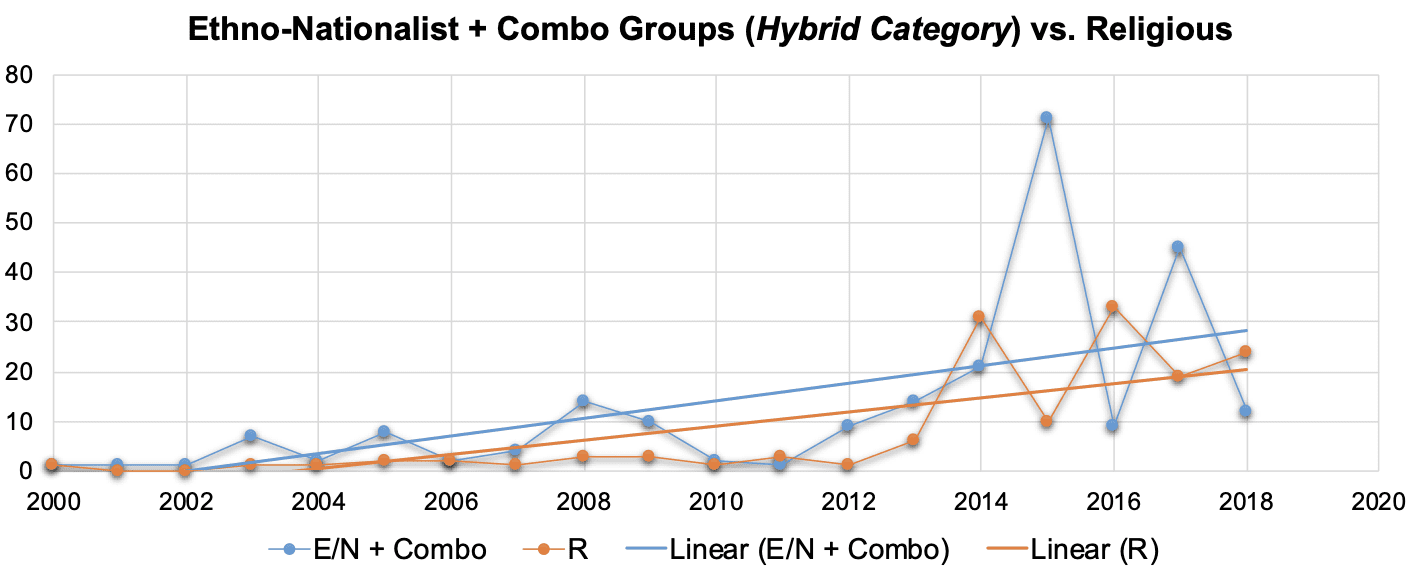
The vast majority of EI attacks were committed by groups that had been in existence for over 5 years, with groups 6-10 years old and those over 40 years old accounting for the greatest number of attacks. The graph below depicts the increase over time of EI attacks by groups more than 5 years old compared to the attack frequency of younger groups, which appears to have remained flat.
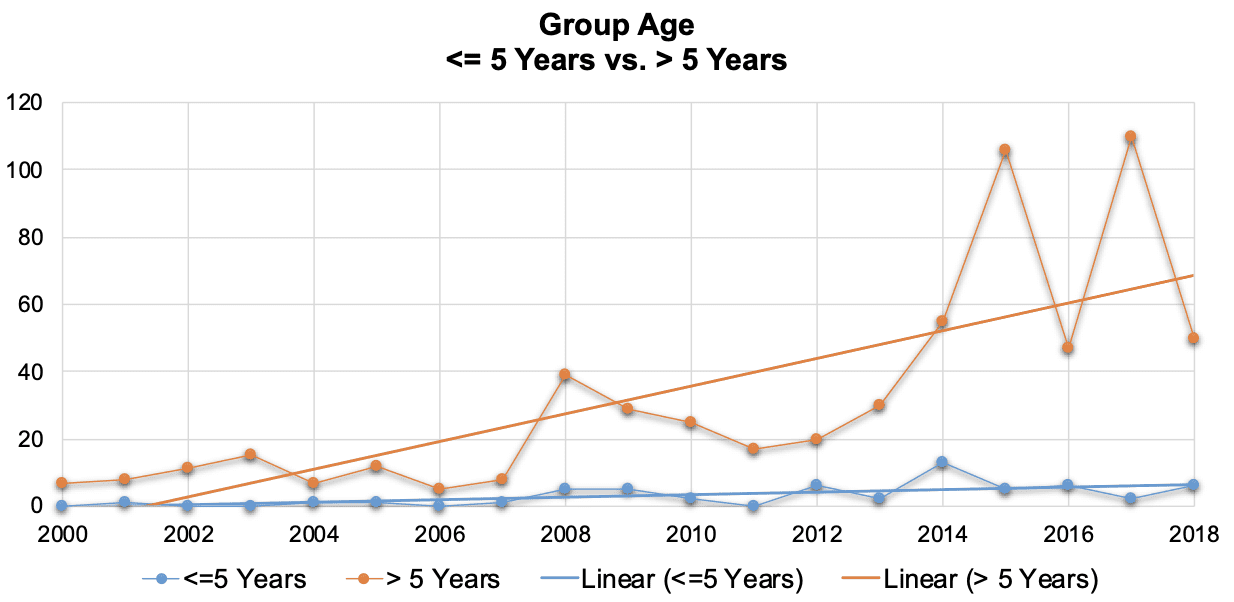
Large terrorist groups (more than 3,000 members) were responsible for 65 percent of EI attacks, which far exceeded the small terrorist groups (1-1,000 members) and medium-sized terrorist groups (1,000-3,000 members). This distribution is depicted in the graph below.
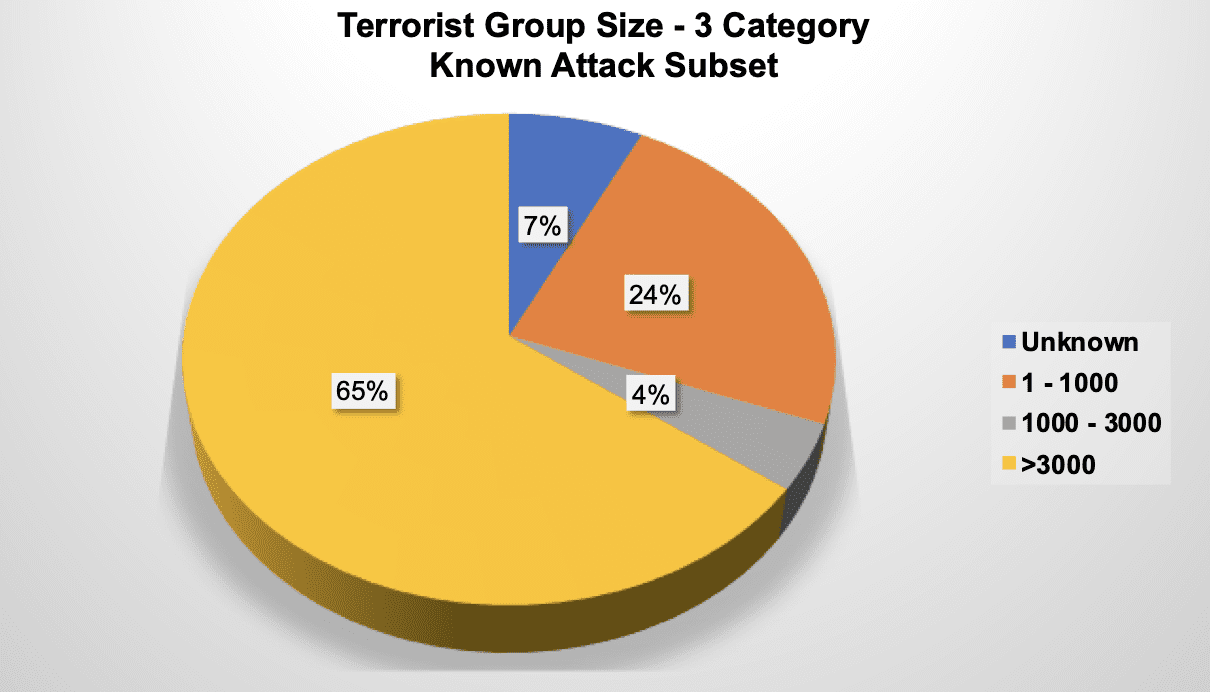
The literature strongly supported the notion that terrorist groups tend to repeat attacks on similar targets (Drake, 1998a; McCormick, 2003; Ackerman et al., 2007; Hoffman, 2017). It is common to find stories in the media of groups repeatedly striking similar targets. The findings in my research supported this assertion. Terrorist groups in the research sample were far more likely to conduct EI attacks if they had two or more previous attacks on similar targets. The analysis showed that 80 percent of the EI attacks were conducted by groups with two or more previous attacks, as depicted in the graph below.
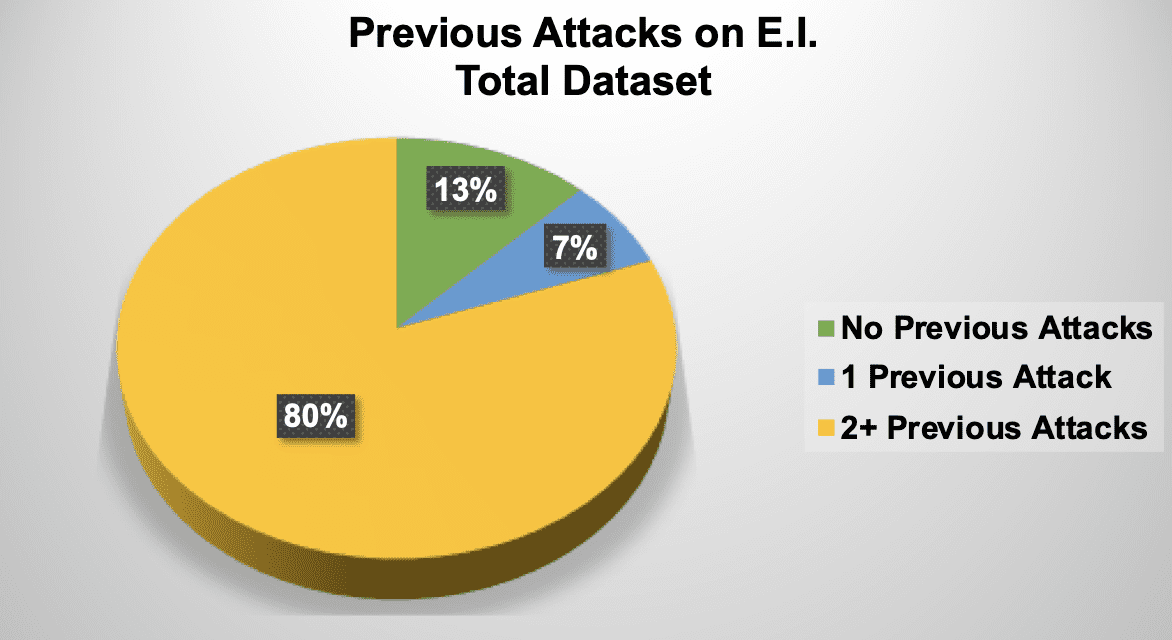
My analysis also examined the role of a group’s operational capabilities and resources related to targeting decisions. Specifically, the question examined here is whether the lack or abundance of operational resources influenced the selection of EI as a target for attack. This question was analyzed using the frequency of previous EI attacks by groups with varying levels of operational resources. Each EI attack in the known subset was coded for the group’s operational resources level.
Each group’s operational resources were ranked using a 1-10 scale. The rankings were based on a subjective assessment and aggregation of the following elements:
Annual revenue ($USD) – if known
Sources of revenue
Number of members
Strength of leadership
Access to weapons/type of weapons used
State sponsorship
Alliances w/other groups
Support from the local population
Access to and use of technology
The rankings exposed a wide disparity of monetary resources, including annual revenue ranging between tens of thousands of dollars up to over $1 billion per year. Similarly, some groups had only a few hundred fighters and poor access to weapons, while other groups had thousands of members and access to armored vehicles and guided rockets. These inequalities included differences in local support, patronage, state sponsorship, and access to sophisticated technologies. The assigned numeric value for each group was compared against the known attack subset to determine the statistical frequency of past attacks.
The largest proportion of EI attacks was conducted by terrorist groups with high operational resources (182 attacks). Groups with high resources (levels 8-10) accounted for 50 percent of the attacks and were much more likely to conduct attacks than any other single category, as depicted in the graph below.

Are EI attacks predictable?
The short answer is no. However, my research experimented with a Bayesian probabilistic tool to quantify estimated values, reduce uncertainty, and assess the threat from any specific group against a specific target, including EI, if the underlying statistical research is performed to establish prior probabilities and conditional probabilities. That said, in the absence of prior statistical frequency of previous attacks, these values can also be established through the elicitation of intelligence experts that have been well-calibrated to estimate probabilities. Experts will be well-calibrated when they can estimate probability ranges where they have at least 90 percent confidence that the actual probability for each factor falls within their stated range (Vogt, 2005; Hubbard & Seiersen, 2016).
Whether using the statistical frequency of past attacks, expert elicitation with a 90 percent confidence interval, or a combination of both techniques for establishing prior and conditional probabilities, the Bayesian tool shows promise for future application. The Bayesian tool also has the potential to predict the estimated timing of attacks or the likely tactics to be employed by the group(s) under consideration. The foundational statistics must be researched and established to identify the group’s tendencies for when to conduct attacks or which tactics to employ. Once these steps are completed, the statistical frequencies can be combined with expert estimates to employ the tool.
Which groups will likely conduct EI attacks?
The statistical findings in my work suggest patterns concerning the proportion of previous EI attacks based on the decision factors. The analysis of the data specifically related to the age, size, and operational resources of a terrorist organization revealed discernible statistical tendencies. Similar observations were made when examining the number of repeat attacks on EI targets by individual groups.
The most likely future EI attacks will be conducted by large ethno-nationalist groups that have been in existence more than 5 years and demonstrate a high level of operational resources. Looking beyond political ideology, many terrorist groups that conducted EI attacks also tended to seize and control geographic territory, set up internal forms of government structure, and provide social services to the populations under their control. These groups will have strong central leadership and have committed EI attacks in the past. The EI targets will be geographically close to the group’s area of operation and will have security vulnerabilities that the groups can exploit.
How is the research useful for homeland security?
Intelligence analysts can use this research to apply greater scrutiny to terrorist groups that score high in most or all the categories. This allows for more efficient resource allocation. Security personnel and planners can build better risk models using design-basis threat models to simulate potential attacks. Better intelligence, vulnerability assessment, risk modeling, and planning logically contribute to harder targets and better-prepared infrastructure operators.
Conclusion
The purpose of my research was to examine the likelihood that sub-state actors will attack EI. The work quantified some of the common assertions that the risk of an attack to the power grid is serious. The research focused heavily on a set of decision influences believed to shape target selection. These decision influences were identified and validated through a review of the literature and applied to a statistical analysis of EI attacks.
Through this analysis, a set of research questions was addressed, and hypotheses were tested. The use of this research method was presented as a heuristic to model an estimation of future attacks. This work was intended to further the protection of the electric power grid from malicious physical attacks.
No comments:
Post a Comment